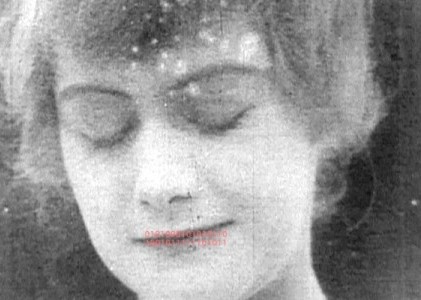Dream Factory
What's in the shadow of the images we know?
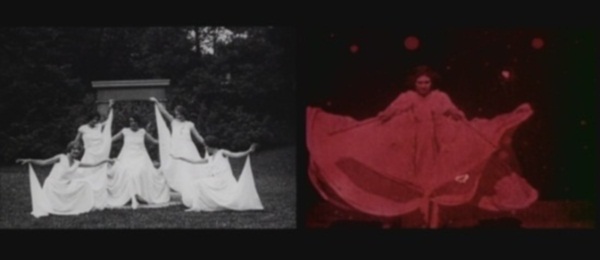
Modern Dances
There is an ephemeral history of cinema, running parallel to the concrete one. Its members include advertising, educational, instructional, and industrial films, often short, produced by private enterprises, and starring either real-life company employees or actors playing them. You may already have an image in mind—a scene of cheerful female co-workers, perhaps, or a mother and child talking, ending with one person turning and delivering a message to the camera. These films are ubiquitous, to the point where nearly anyone who's ever watched TV has an idea of them, though their directors, actors, and years are often unknown. When compared with what we typically think of and consume as movies (either projected in a theater, or watched on DVD or online), they seem like a silent majority. The archivist Rick Prelinger, responsible for the world's largest known collection of ephemeral films, estimated in 1999 that the United States had produced 100,000 feature films at most, and somewhere between 500,000 and 600,000 ephemeral works.
He gave these numbers in an e-mail exchange with the French Canadian researcher and filmmaker Caroline Martel, who was interviewing him, and whose installation Industry/Cinema runs May 17-August 12 at the Museum of the Moving Image. Martel's split-screen video work, which visitors encounter as they walk up the Museum's grand staircase, contrasts scenes from industrial films on the left side (Industry) with clips from canonical, recognizable films on the right (Cinema). Employees of the Western Electric and Chevrolet Motor companies turn nuts and bolts in Frank B. Gilbreth's The World's Telephone Workshop (1924) and Master Hands (1936) next to Charlie Chaplin in Modern Times (1936); a presentation of an AT&T machine singing "Daisy" in The Speech Chain (1963) accompanies HAL 9000's death dirge in 2001: A Space Odyssey (1968); Réseaux 2000, a 1991 Bell Canada film promoting the wonders of technology, accompanies a young Jeff Bridges's digital journey through the computer-animated Tron (1982).

Lyrical Machines
"I see it as a comparative study," Martel says over Skype of her 22-minute looping installation, which compares seven sets of films in all and which was originally commissioned for Montreal's Gallery Dazibao in 2009. The inspiration to juxtapose the two kinds of filmmaking (or "image regimes," as she calls them) arose out of "the idea that these films are in the shadow of film/media history as if they were in our collective unconscious, ready to be revealed." The shadow works come from her own private collection of more than 200 industrial films recorded on VHS tapes, found in archives ranging from the Library of Congress to the Bell Canada Historical Services. Much of the pleasure she felt in making Industry/Cinema, she says, came from the thought of being able to share them.
Martel, born in 1973, has known ephemeral films since high school, when a chemistry professor would show Hydro-Québec movies on a 16mm projector during class breaks. She got to know industrial films in particular in the mid-1990s, while researching a project for her bachelor's degree in communication studies at Concordia University. She was looking for moving images of female telephone operators, and found it "impossible." No records existed of them, save for recruitment, training, and advertising films made by their employers, showing them at work. "I began to sense that these archival images were like phantoms, ranks of smiling simulacra," Martel writes over e-mail.
The end result, rather than a direct historical account, was a montage film about how the popular images of these women—the "voices with a smile," as PR labeled the girls—were built. The Phantom of the Operator (2004), which will screen at Industry/Cinema's opening, shows black-and-white, grainy scenes of girls flipping switches, accompanied by a floating female voiceover. "I am the ghost of invisible women workers without whom the 20th century would have never been the same," the voice says, as unnamed ladies work with electrical cables and train themselves to grin. "The rhythm of our gestures set the pace of call production."
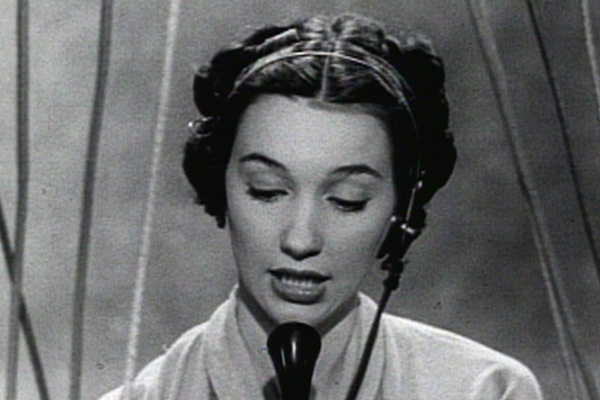
The Phantom of the Operator
Phantom suggests that over time real-life telephone operators came to mimic their constructed images. From the beginning of her work as a filmmaker, Martel saw technology as coming from people, and people modeling themselves after technology. This might seem an obvious point, since technological works (including movies) must always be made and operated by human beings, but for her man and machine's linkages were unusually close. She wasn't only presenting hidden films, but remembering forgotten people.
Phantom audiences responded eagerly, Martel says. The people she talked to at Q&A sessions felt "that those images had already been shown somehow," and that they intuitively recognized them. She saw that there was a willing public for these films and these people, and that they could be received as readily as more celebrated cinema, and so five years later returned to them. Industry/Cinema's first pairing is of girls in white dresses frolicking outside, taken from How Business Girls Keep Well (1920), next to a woman twirling her dress in the air in Annabelle Serpentine Dance (1894). You might not recognize the second title, but you've likely seen the movie before reading this article—it's frequently shown in film history montages.
Although Business Girls's credited author is a company (the Bell Telephone Company of Canada), it was filmed by a group of uncredited individuals; and although Annabelle Serpentine Dance's credited author is a lone director (Thomas Edison), it was filmed by a group of uncredited individuals working for a company. "Because I'm a filmmaker, I always think about means and modes of production," Martel says.
The installation's juxtaposition of equally held images leads a viewer to make this and other associations, many related to a continuously flowing larger thought: cinema is and has always been an industry, producing mechanical products, and since its inception other industries have promoted themselves through cinema. If anything, the work's presentation at the Museum of the Moving Image guides this flow even more than its initial incarnation did. Originally the industrial and canonical films were screened on two separate rotating projectors, which would overlap at key moments; now they exist on one large flatscreen together, and the viewer's eye can wander back and forth. "It is a movement. It has to be one image," Martel says.
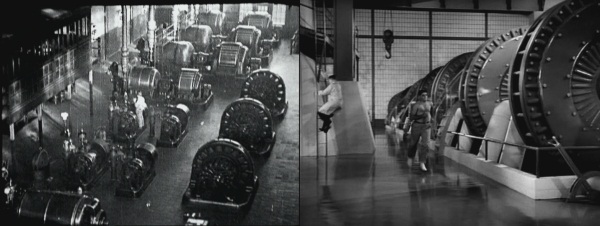
Work Mechanics
Sometimes the contrasts give an immediate film history lesson—you can see for yourself how closely Chaplin studied industrial films, for instance, and how carefully he copied workers' movements. Yet they often create a broader, more fruitful confusion. The appearance of Walter Ruttmann's well-known Berlin, Symphony of a City (1927), part of the city symphony tradition which included entries ranging from Moscow to São Paulo, alongside the less-known Henry Strauss Productions film Her City (1962), an American industrial film about how telephone operators connect people in metropolises, shows them both as documentaries of daily urban life, with people passing by storefronts, cars crossing roads, and construction underway. They hold equal value as such, to the point where without context one might not know which belongs to Industry and which to Cinema. A similar kind of confusion holds true for the contrast of the Jerry Fairbanks Production Invisible Diplomats (1965) with the Hollywood production Pillow Talk (1959), both fictions. Both feature recognizable actors (Ruta Lee, Audrey Meadows, and Gig Young in one; Doris Day, Thelma Ritter, and Rock Hudson in the other) playing American professionals in scripted scenes. A major goal of both films is to advertise not only a specific product of work in an entertaining way, but work itself. The working life continues, we sense, even after the workday closes. Ruta Lee enters her apartment in a light green secretary outfit that's a similar color as Doris Day's pajamas; the businessman's work clothes in one film look similar to what Rock Hudson wears lounging at home in the other.
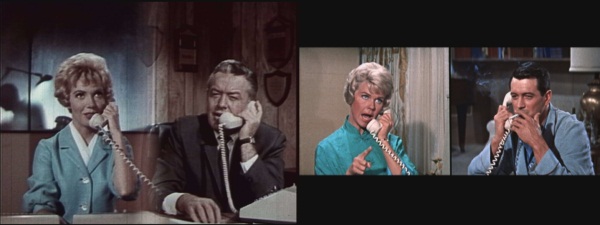
The Romance of Technology
The installation's sounds comment on each other as much as its images do. Martel has maintained all the films' original soundtracks, but at any moment an installation visitor is only listening to one, which he or she chooses by flipping a switch on one of the 20 pairs of hanging headphones (a large sign in the space demonstrates how). You can watch satellite dishes while hearing a big-budget fiction film's production credits spoken aloud. "The ability to jump between soundtracks creates the feeling of almost being able to eavesdrop on the films," the Museum's Chief Curator David Schwartz writes over e-mail, "to hear their sound as a subconscious element." They also, in the best tradition of advertising, provide semiconscious messages. A couple in Truffaut's Fahrenheit 451 (1965) sit in front of a flatscreen TV prototype whose lovely female announcer says, "Any similarity with the truth or with real life will be purely coincidental," addressing the animated bare-breasted lady in the Bell Canada film Along These Lines (1974) next door as well as the pleasures of television in general. "Modern computers use fast, magnetic memory devices," the 1968 Bell Laboratories film The Thinking Machine says, in the same year that Kubrick's Hal 9000 offered a strange and captivatingly gross mimicking of human thought. "This film will show some of the storage devices used in machine memory and explain how information is stored in them."
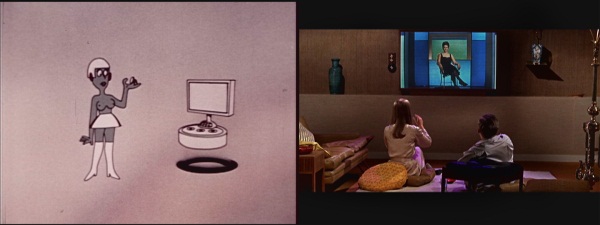
Optical Impressions
So does Industry/Cinema. Though the clips don't always proceed in chronological order, the larger work has a general chronological structure that suggests machine memory developing, to the point where, as the last industrial clip says, "The connections created by telecommunications networks are of vital importance in facing the challenges of the next millennium." This is almost self-evident but, as with Phantom, it's easy for conflicting feelings to arise as you watch—wonder at the human ability to develop technology, and melancholy at the progression toward machine labor replacing human work. The installation's first pairing is of images of dancing women; its last is of a digital effect-heavy advertisement for computer technology with Jeff Bridges literally merging with a computerized world. Telecommunications advertising replaced the operators with machinery itself. "Technology became sexy," Martel says.
Yet while Phantom tracked this change mournfully, Industry/Cinema does so in a more lively and playful way, largely through how Martel allows visitors the very human element of choice. In addition to choosing where to look and what to listen to, you also choose your own histories. Because it is a looping installation rather than a film, you can enter the story at any time, and watch it continue, or simply exit. You literally choose where you stand in relation to the piece, and if you don't like your position, you can easily change it. You choose how near or far you wish to be to these stories of technological development, the most recent of which comes from 1991. By watching these images from the past, you can become more aware of yourself in the present, and can imagine an unknown future. "I think that spectators are always active in how they make sense of stuff," Martel says. "Here they have an active role to play, to interfere with the screen."
One should hasten to add that all the installation's images come from films made in the United States, Canada, or Western Europe. One could also rightly reply to Martel that the advertising industry of the Western First World long ago figured out the element of choice as a great way to pitch products, most of all the industry itself—this product is fantastic, for innumerable reasons, but the best thing about it is that you choose to buy it. But the pitch is valid. Even if we buy a product because we watched an actor use it on television or in a movie theater, we choose to buy the product. We also choose to watch the advertisement, and to believe it, to begin with. And we enjoy making these choices, perhaps because making them is proof of having them. If it's running smoothly, Industry/Cinema makes us a little more aware of our capacity for choice, and of how choosing to submit can be a demonstration of power. It reminds us how we can choose to think of people as images on screens, a choice many of us make with increasing frequency, to the point where it can become subconscious. In projecting ourselves through technological devices, we also project ourselves onto them. Man and machine are merging. Can thinking, too, become robotic? Does it have to?
Thanks to Jason Eppink, Sam Love, Marion Miclet and all the unsung workers at the Museum of the Moving Image. ![]()
LATEST ARTICLES
-20140814-173707-thumb3.jpg)
Fighting Words
by Imogen Sara Smith
posted August 12, 2014

Fighting Words, Part 2
by Imogen Sara Smith
posted August 20, 2014

On the Margins: The Fil…
by Andrew Chan
posted August 12, 2014

Robin Williams: A Sense…
by David Schwartz
posted August 12, 2014
 Dream Factory
Dream Factory
 Industry/Cinema (clip 2)
Industry/Cinema (clip 2)
THE AUTHOR
Aaron Cutler is a writer in São Paulo. His film writings can be found at http://aaroncutler.tumblr.com.
More articles by Aaron Cutler
